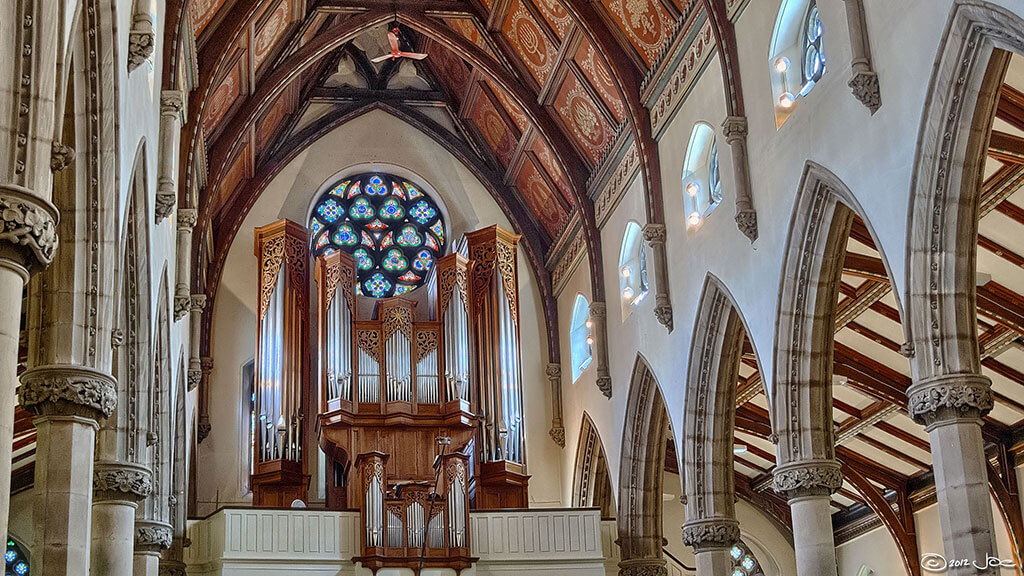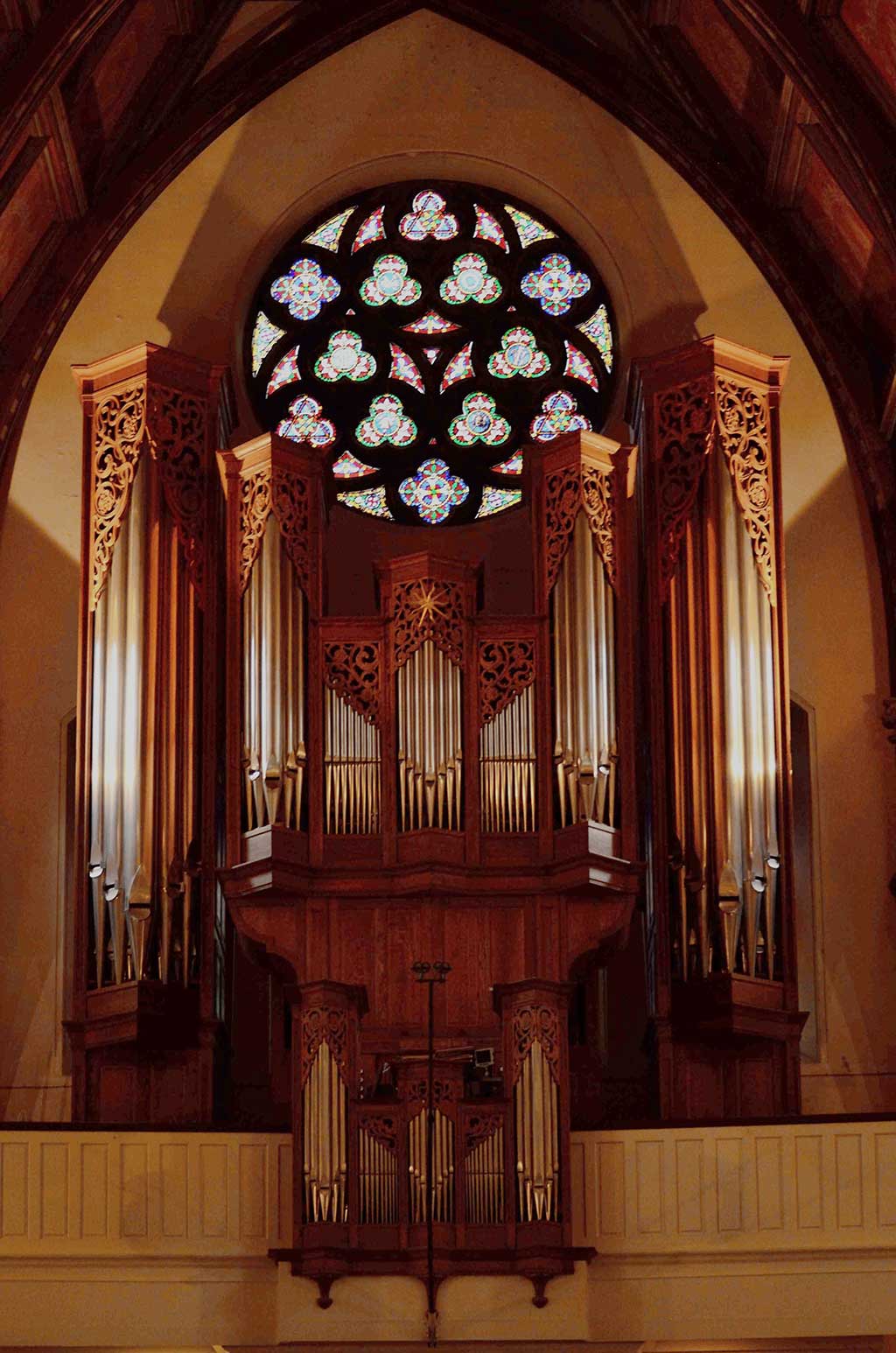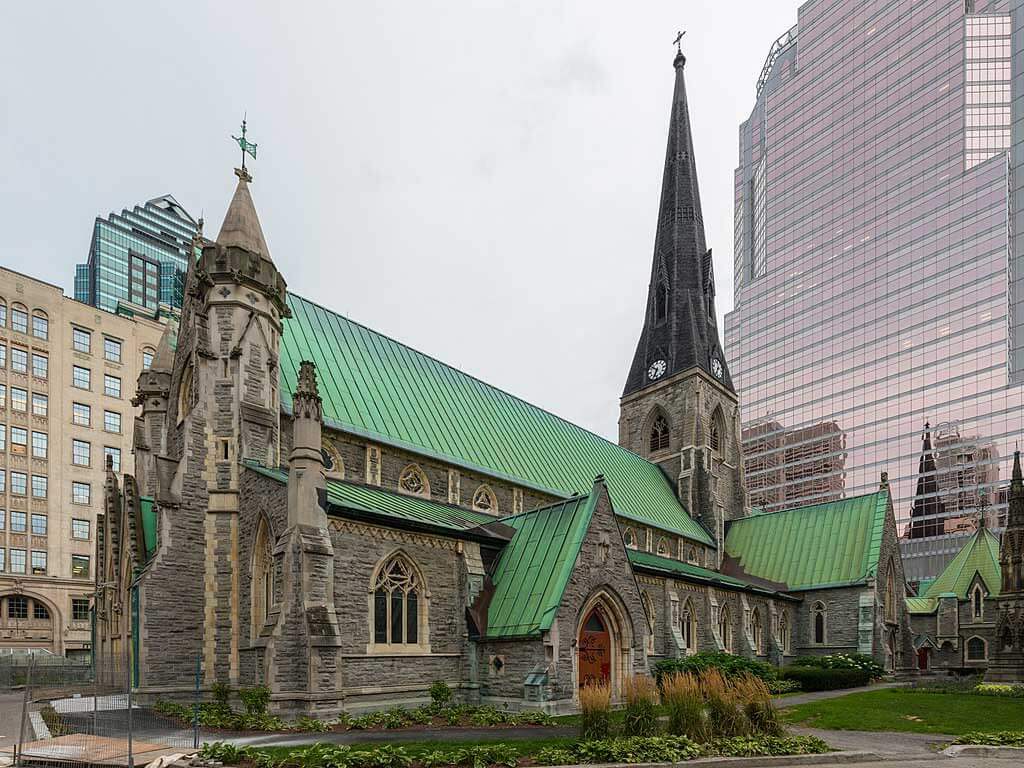
Anyone who has spent time in downtown Montréal will recognize the Gothic Revival architecture and red doors of Christ Church Cathedral, the seat of Montréal’s Anglican Diocese situated above the Promenades Cathédrale.
Constructed in the 1850s, this building was the third to house the parish after the first two were destroyed by fire. Today, the Cathedral hosts not only Anglican services several times a week (including three Sunday services with music), but also a variety of social programs and secular concerts including the Oasis Musicale series.
Interview with Patrick Wedd
The musical focal point of the Cathedral is its Karl Wilhelm organ, built in Mont-Saint-Hilaire and installed in a newly-built organ loft in 1980. The Cathedral’s music director is Patrick Wedd, a renowned organist and choral director with a long history in both liturgical and secular music.
“I’ve been in church ever since I was in the womb,” jokes Wedd. “I started organ lessons when I was 11 when I had enough piano in my background and was big enough to play the organ. And had my first job when I was 12 years old.”
Wedd held various positions in churches in Ontario’s Niagara peninsula before the age of 18, when his career moved to Toronto, where he studied organ at the University of Toronto, and Vancouver where he did a graduate degree while also working as a musician. He has performed on many organs around the world, has served as organ and choral pedagogue, and has recorded organ albums with Naxos and the CBC.
“I’ve had a very busy and fortunate life as a performing musician. I’ve done church music almost 60 years now. And 21 years have been here at the Cathedral, which has been a very wonderful thing for me. I’ve had a very fortunate career and the organ has been very much a part of it.”
The Karl Wilhelm organ
The Karl Wilhelm organ is the Cathedral’s first organ to be situated on the western wall of the building, behind the congregation. Originally, the organ was located near the choir stalls in the chancel, an acoustically inferior placement.
“The decision to put the instrument in this place was at Karl’s insistence, says Wedd. He did not want to have to build an instrument in a closed-off part of the building where it wasn’t going to sound.”

However, a memento of the old organ remains on the eastern wall above the crossing, where a façade of false pipes soars above the pulpit.
“Around the year 1900, one of the wealthy Americans who summered every year in Montréal decided that the organ should have an echo division, Wedd explains. When the decision was made to move the organ, the casework, built in Boston in the early 20th century, had become so much a part, visually, of the building that they left it there.”
In the late 1970s, the existing organ was deteriorating and the Cathedral was faced with a decision about its replacement.
“They could have rebuilt what was there, as has often been the case with instruments here in town and all over the world, says Wedd. But it never had been really satisfactory in terms of actually making music for the room. Gerald Wheeler was the director of music then, and he and the various people in charge made a very bold move.”
That move was to commission a brand-new mechanical action organ from Karl Wilhelm, who had started his own workshop in 1966 after coming to Canada from Germany in 1960 to lead the new mechanical action department at Casavant Frères. At the forefront of technological innovation, Casavant had been building electric action organs since the introduction of the technology, but in the mid 20th century, there was a shift in the organ world back towards the traditional mechanical action or tracker organs, in which the keys and pedals are mechanically connected through a series of rods or trackers to the pallets which open and close the air valves, allowing air into the pipes.
“There is a sense of direct linkage between the player and the sound-making apparatus, as you would have on any other instrument, explains Wedd. Whereas playing an electronic action instrument, you’re basically playing a doorbell. Returning to a system whereby the player feels a more direct contact with the instrument can only be a good thing. Even in very large instruments, there’s still that sense of intimate contact.”
The style of the organ was also an important consideration for the Cathedral.
“Think of the change from Bach to Mozart to Beethoven to Liszt — there’s organ music from all of those periods. And ideally, each one of them demands a different style of organ building,” says Wedd.
“Here was Christ Church Cathedral, an avowedly non-Roman establishment in the great Anglican musical tradition, which everyone thought implied a big Romantic-style instrument in the style of many of the cathedrals in Britain. Gerald [Wheeler] and his bunch said, ‘Well, we’ve got these very fine builders in town, they’re Quebec builders, and they’re building instruments in the latest style now; why don’t we commission one of them?’”
Christ Church Cathedral
Wilhelm had been building mainly two-manual instruments. Christ Church Cathedral’s commission was, at that point, his largest ever, with three keyboards and a pedal division, 43 stops, 63 ranks, and a total of 2,778 pipes.
“The instrument is quite generously-scaled,” says Wedd. “The middle keyboard is the major part of the instrument, in a case that’s directly over the player’s head, very visible from the nave, and speaks directly down. The bottom instrument is so called because it’s at the player’s back, and it’s the smaller case that one sees kind of hanging as a pendant at the front of the gallery, and in those positions, those two divisions will play antiphonally one with the other in very Classical ways.
“The top manual is the slightly more Romantic part of the instrument; it controls the récit or the swell, which is in a large box behind the rest of the organ. Gerald was able to convince Karl to increase his musical scope of this instrument, largely in the récit division. That allows us an expanded musical dimension that we would not have were it not there. There is also a small echo division, which he added to the original specification, and its pipes, very much in the style of 18th-century instruments, are actually directly over the music desk. And then of course in the two large towers on either side, towards the back of the gallery, is the pedal division which has the largest pipes, many of which are visible in the façade.”
The organ has seen one major addition since its installation: the addition of a 32’ reed to the pedal division, added by Wilhelm in 1992.
“That adds a real gravitas to the instrument, which is very helpful since the room is only of a modest acoustic — we do not luxuriate in the very long reverberation times of the Oratory or Marie-Reine-du-Monde. The Roman Catholics have all the good acoustics in town,” chuckles Wedd. “The lower frequencies have always been challenged by the acoustic the instrument is in.”
Since its inaugural concert given by the Lagacés in January 1981, the organ has shown its versatility.
“The instrument has reflected the long history of the organ in terms of showing how well it can reflect the colours and the styles that are required for very different composers »
« Karl would like to think it’s a German Baroque instrument, and I think that one of the things it does best is to play Couperin and Vierne and all of the wonderful Classical Baroque French music just absolutely naturally, Wedd gushes. We’ve done lots of wacko contemporary things with it. Where the mechanical action comes in very handy, playing contemporary pieces by the great 20th century avant-garde composer György Ligeti, who wrote this famous piece called Volumina in the 1960s, where he often asks for stops to be drawn only partially, so that the air pressure is not the complete pressure, and the pipes only partially speak and create all kinds of delicious overtones and stuff that you can’t do on an electronic instrument.”
The organ has been the object of many, many concerts, including compete cycles of the organ works of Bach, Buxtehude, Messiaen, and other composers. It has attracted visiting organists from all over the world and has fostered learning opportunities for many McGill organ students. But as Christ Church Cathedral runs its first fundraising campaign in over 100 years, there are still upgrades on the table.
“The acoustics of the room, right from the very beginning, has been challenging to the bass frequencies,” says Wedd. Juget-Sinclair Organbuilders, whom Wedd describes as “very talented builders, very much at the forefront of the next generation,” have proposed a way of selectively increasing the air pressure to the largest, lowest pipes. If we can do that, we can actually raise the amount of sound that the pipes that are already there — we don’t need to replace the pipes, we just need to put more wind into them. I think it would increase even more the musical capacity of the organ. One of the wonderful things about a pipe organ is the way that those low frequencies can permeate a building.”

While the Cathedral’s most urgent need is the critical repair of its spire, “we are very much hoping that a modest amount of money will go toward some aspect of the music program: the organ is one, and a new grand piano for our very thriving concert series would be another,” says Wedd.
“We are really quite optimistic about the future of our instrument and how it’s going to contribute to the musical life of the world.”
LIRE AUSSI:



